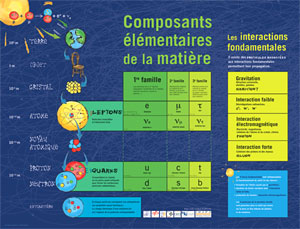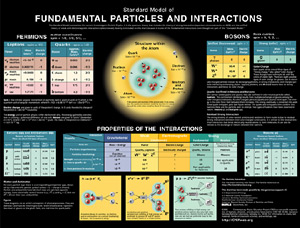Particle physics goes to school
Students around the world are familiar with the periodic table of elements, a chart that outlines how protons, neutrons, and electrons form more than 100 different types of atoms. But do students know that quarks, gluons, and other fundamental building blocks of matter also have a table of their own? In honor of the World Year of Physics, a group of French physicists and teachers set out to provide all high school classes in France with a new poster representing the elementary components of matter. A team of graphic design students from École Éstienne in Paris created the poster, and 20,000 copies were sent to 3600 French high schools on October 10. The schools also received copies of an eight-page leaflet and a CD that provide teachers and students with additional information.
The French initiative followed the groundbreaking work of the Contemporary Physics Education Project, a US-based non-profit organization that has created educational material for more than ten years (www.cpepweb.org). CPEP is well-known for its series of posters that explain the fundamental nature of matter and energy, and it has distributed more than 200,000 posters and other educational products around the world.
Featuring fewer details and a new design, the French poster is a simplified version of CPEP's Chart of Fundamental Particles and Interactions. CPEP's award-winning Web feature "The Particle Adven-ture" (www.particleadventure.org) provided the basis for the content on the French CD. Other nations are welcome to reprint or adapt the new poster free of charge (available in French and English at http://sfp.in2p3.fr/affiche). Canada has already distributed 6000 posters among its high schools, and several other countries have shown interest. For information, contact Guy Wormser, LAL Orsay, at wormser@lal.in2P3.fr.
Kurt Riesselmann
|
|||||||||








